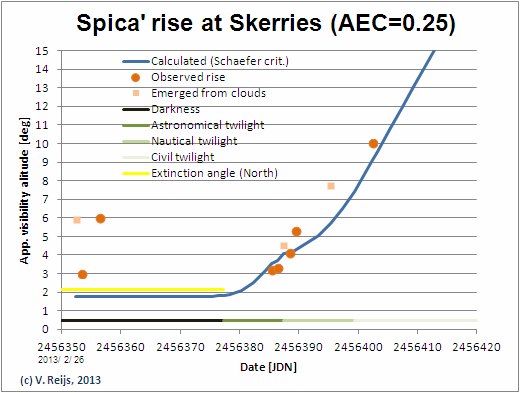Celestial object phenomena
Several aspect (differentia) of celestial objects (stars and inner-
and outer planets) movements along the sky are important:
Object Types
The following object Types (depending on location and
meteorological conditions) can be defined:
- Circumpolar (C)
An object that never sets and thus is always visible; in naked
eye astronomy: it is always above its extinction angle.
- Curtailed Passage (CP)
For an object far north of the ecliptic.
- Arisen and Laying Hidden (ALH)
For an object south of the ecliptic (ALHa) and somewhat northern
and southern of ecliptic (ALHb). These sub Types have not been
found/recognised in any literature. e.g Brady (2011 and pers.
comm. 2017) (if wrong, let me know). But
the underlying Phase sequences are clearly recorded by Ptolemy for many stars.
- Invisible (I)
An object that never rises and thus is never visible; in naked
eye astronomy: it is always below its extinction angle.
An object of a certain Type will exhibit certain sequence of Phases and in between
the Phases there are Periods
forming the mean periodicy of
the object.
Below picture shows the Object Type
changing depending on the RA/DEC of the object (for location London,
1948CE and AEC=0.25). The number in the cells refer to the Type Code
mentioned in the table below:
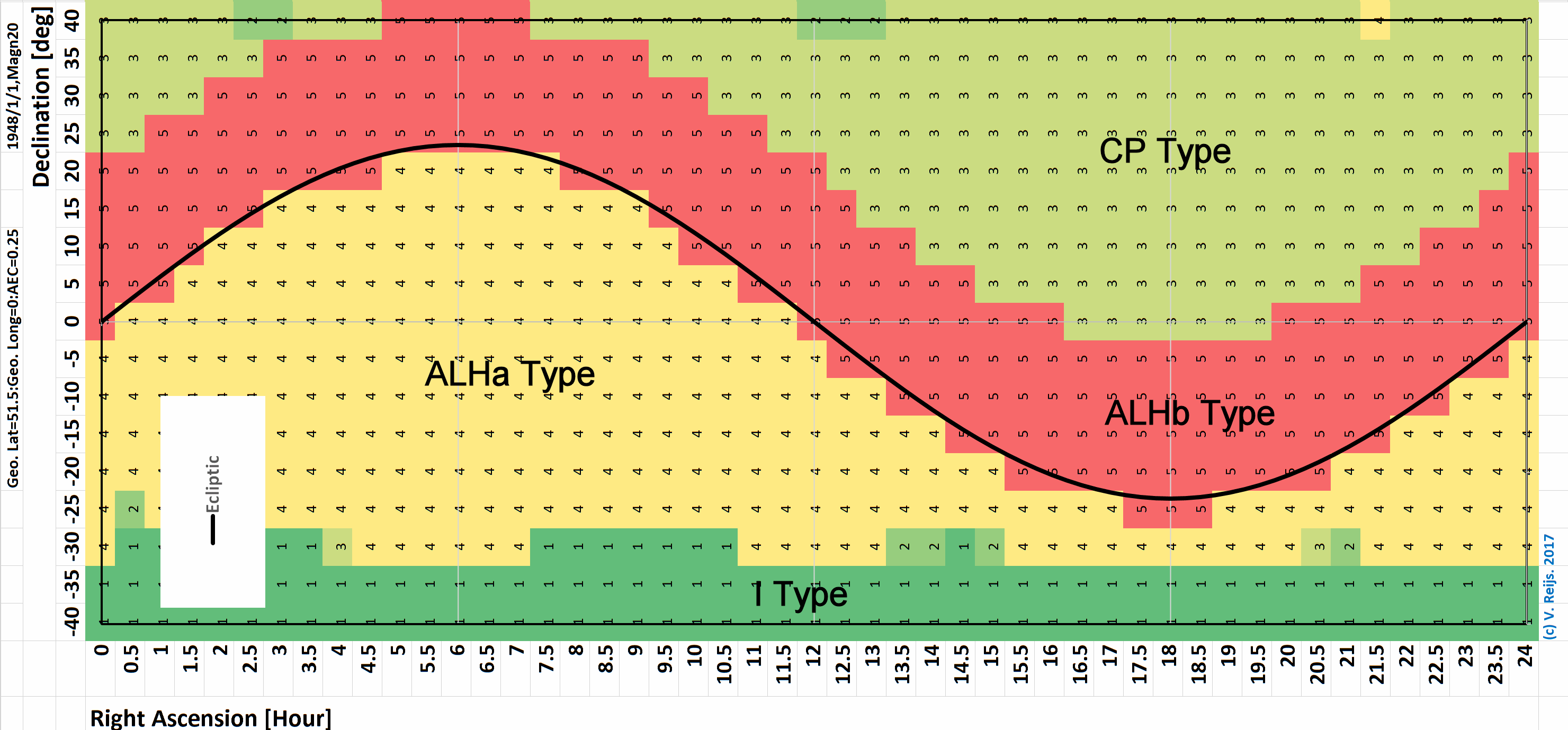
The Type of an object can change to another (neighboring) Type
depending on the atmospheric conditions.
The calendar entries of Ptolemy show the
above mentioned (sub) Types: CP, ALHa and ALHb.
Looking at Ptolemy's calendar
entries the following Type changes are seen for the same star
when decreasing the geo. latitude:
ALHa -> ALHb: Alphard, Betelgeuse, Rukbat
CP -> ALHb: Alpheratz, Altair, Menkalinan,
Object Phases
Naming phases
What would be a good way to name object (apparent) Phases for stars,
outer- and inner planets?
- Toomer's naming in Ptolemy's translation combines the sun's
moment (dawn/evening) and the location of the visibility on the
actual moment (east/west).
- Or should dawn/dusk be replaced by dawn/evening or
morning/evening to use more equivalent concepts.
- Instead of east/west one could use rise/set.
- First/last is a pair of words that describes for a few Phases
very well what happens on morning or evening (MF, ML, EF, EL).
- For some Phases the celestial object is still visible the day
before and after the Phase (AR and CS), while for other Phases
the celestial object is not visible the day before/after the
Phase (MF, ML, EF, EL). So there are conceptually differences in
observation.
So for these reasons this web site will use the six terms: MF, ML,
EF, EL, AR and CS. These will be defined in a
below section.
Star and outer planet Phases
Apparent Phases
(Apparent) Phases** (Ptolemy, 1993, start
Section 2, page 3 and end Section 4, page 5; Ptolemy, 1984, page 409
to 410 [called 'configurations']) that occur during mean periodicy of the star
(and outer planets [Mars, Jupiter and Saturn]) are (depending on
location and meteorological conditions)
described by Kolev [2006] as follows:
- Morning First (MF)
"At a certain moment, the star (rise) becomes visible
for the first time in the (rising) solar halo."
(page 10)
- Evening Last (EL)
"The light halo of the setting Sun approaches the star with
every day. Then a day comes when the star (set) is so
close to the solar halo that it is hardly visible. The
next day the star is not visible at all." (page 14)
- Acronychal Rise (AR)
The rising of the star is happening around sunset
"You watch the place on the sky where the star appears in
deep night. The last evening when the star appears on that
place is the AR event [Phase]. The next day it appears
higher." (Rumen Kolev, pers. communication [2009])
'Appears in deep night' I assume to be the extinction angle of the star.
According to Rumen ~0.5 degrees higher than the extinction angle
(pers. comm. [2013]). I have the idea that this change of
appearing place might be at the start of the transition from
scotopic to photopic vision (change from darkness to
astronomical twilight).
An example of observation of Spica's rise, where the end of the
black horizontal line is the date of Acronychal Rise (Julian
Date Number: 2456377):
- Cosmical Set (CS)
The setting of the stars is happening around sunrise
You watch the place on the sky where the star appears in deep
night. The first morning when the star appears on that place is
the CS Phase. The next day it stays at same apparent altitude
(analogue to Rumen Kolev's definition of AR).
'Appears in deep night' can be seen as the extinction angle of the star.
MF and EL (or swapped) Phases are following each other up, same with
AR and CS (or swapped) Phases.
Furthermore the Type is also indicative for the sequence of Phases
(Lehoux [2000, 12], who paraphrases Neugebauer [1975, 759-60]):
- CP Type: the Phase pair (ML,EL) has the Phase sequence: MF and
then EL
- ALH Types: the Phase pair (ML,EL) has the Phase sequence: EL
and then MF
Below is a table that shows the (apparent)
Phase and Period sequence for each Type (in this
graph is a graphical representation of the Types an object
goes through):
| Type |
Description |
Ptolemy
|
Phase and Period sequence |
Type Code |
| C |
Circumpolar |
|
SA |
1 |
| CP |
Curtailed Passage(b)*** |
All
year long
|
MF |
|
EL |
|
CS |
|
AR |
|
MF |
3 |
| SRS |
RS |
SA |
SS |
| |
|
|
|
| ALHa |
Arisen and Laying Hidden(a) |
Night
pathed
|
EL |
|
MF |
|
AR |
|
CS |
|
EL |
4 |
| NS |
RS
|
RSS |
SS |
| |
|
|
|
| ALHb |
Arisen and Laying Hidden(b) |
Dock
pathed
|
EL |
|
MF |
|
CS |
|
AR |
|
EL |
5 |
| NS |
RS
|
RSS |
SS |
| |
|
|
|
| I |
Invisible |
|
NS |
6
|
Remark:
** Many people name these Phases: Heliacal
Events. Both terms will be used interchangeable on this web site.
Topocentric Phases
Above (apparent) Phases have been mentioned, but of course
Topocentric or Geocentric (ture) Phases can also be recognised. In
the Topocentric Phases the meteorology and refraction are not
included, while the star's and Sun centre's topo/geocentric altitude
are zero (in PLSV: one puts all Visibility parameters to zero).
Ptolemy talks in that case about True simultaneous phases (page
xiii-xiv) (Toomer, page 410-413).
This website does not use by default the Topocentric (true) Phases
but (apparent) Phases, unless the word 'Topocentric' is explicitly
added.
Inner planet Phases
The inner planets (Mercury and Venus) have the following four
Phases:
- Morning First (MF)
At a certain moment, the inner planet becomes visible for the
first time in the (rising) solar halo.
- Morning Last (ML)
The light halo of the rising Sun approaches the inner planet
with every day. Then a day comes when the inner planet (set) is
so close to the solar halo that it is hardly visible. The next
day the inner planet is not visible at all.
- Evening First (EF)
At a certain moment, the inner planet becomes visible for the
last time in the (setting) solar halo.
- Evening Last (EL)
The light halo of the setting Sun approaches the inner planet
with every day. Then a day comes when the inner planet (set) is
so close to the solar halo that it is hardly visible. The next
day the inner planet is not visible at all.
Some other definitions
Multiple other terms are utilised in literature, here are some of
the mappings (for apparent event) used on this website (MF, ML,
EF, EL, AR and CS):
- Meeus [1997]
Heliacal Rise -> MF
Heliacal Set -> EL
- Ptolemy ([1993], Section 4, page 5)
Morning Rise Phase -> MF
Morning Set Phase -> CS
Evening Rise Phase -> AR
Evening Set Phase -> EL
- Ptolemy ([1984], page 409-410)
Dawn Easterly configuration -> MF
Dawn Westerly configuration -> CS
Evening Easterly configuration -> AR
Evening Westerly configuration -> EL
- Evans/Autolytus ([1998], page 191) Robinson [2007, page 256]
Morning rising phase -> MF
Morning setting phase -> CS
Evening rising phase -> AR
Evening setting phase -> EL
- PLSV
Fist Visibility -> MF
Last Visibility -> EL
Evening visibility begins -> EF
Evening visibility ends -> EL
Morning visibility begins -> MF
Morning visibility ends -> ML
- Brady (pers. comm., 2012]
Heliacal Rising (ALH) -> MF
Morning Rising (CP) -> MF
Morning Setting (ALH) -> CS
Heliacal Setting (CP) -> CS
Acronychal Setting (ALH) -> EL
Evening Setting (CP) -> EL
Evening Rising (ALH) -> AR
Acronychal Rising (CP) -> AR
Her terminology is also taking into account what the star does
after the 'transitional event' (so combing Phase and Period).
Her 'stage' (Brady, 2011, page 45) might be mapping the Period;
her 'group' seems to be the Type; her 'transitional event' maps
on the Phase; and her 'phase' is the full star's behavior over
the mean periodicy of the star (so possibly includes 'stage',
'group' and 'transitional event').
- skyscapeR (version 0.2.2), looks to
follow Brady for at least its 'events'
phase -> Type
event -> Phase???
season -> Period
Heliacal Rising -> MF
Achronycal Setting -> EL
Setting -> SS
Rising -> RS
Rising and Setting -> RSS
Arising and Lying Hidden -> NS
- Swiss Ephemeris [2012]
Does not have at this moment AR and CS in default mode, due to
lack of scientific definition. This needs to be studied. If the
helflag includes SE_HELIACAL_AVKIND_VR, one can calculate the AR
and CS using Reijs' definition (see next bullet).
- ARCHAEOCOSMO
It has similar code for MF, EL, AR and CS (finding the lowest
object's altitude for these Phases). This does not fully map
Kolev's definitions of AR and CS. This needs to be studied.
- Some unhelpful definitions of Acronychal Rising floating
around:
- Swerdlow ([1998], page 24) quotes Neugebauer's Greek-letter
phenomena:
Acronychal rising, in the east just after sunset slightly
before true opposition
- Quoted by R. van Gent (pers. communication [2009]) from
other source:
Traditionally, the (apparent) acronychal rising of a star is
defined as the last evening when the star can be seen rising
in the east just after sunset.
- Queried by Schaefer (Schaefer, 1987, page S31)
...how is the end of twilight defined?
Object
Periods
The following star Periods (Ptolemy, Section 5, page 5) can be
seen in the sky during one night (this is depending on location
and meteorological conditions):
- Non visible Star all night (NS)
- Rising Star in night (RS)
- Rising and Setting Star in same night (RSS)
- Setting Star in night (SS)
- Setting and Rising Star in same night (SRS)
- Star All night visible (SA)
These Object Periods are between Object
Phases (Ptolemy, Section 5, page 5). The Periods that a
certain Object Type can exhibit are limited and have one of the
following sequences:
- C: only SA
- CP: SRS, RS, SA, SS,
- ALH: NS, RS, RSS, SS
- I: only NS
Examples
CP Type***
Ptolemy also recognises this sub Type: CP as double visible
(Evans, 1998, pp 196-197).
This is an example for Arcturus (RA= ~14.5h:DEC= ~19; including
refraction [Apparent], but no detailed meteorological conditions
as PLSV does not include this):
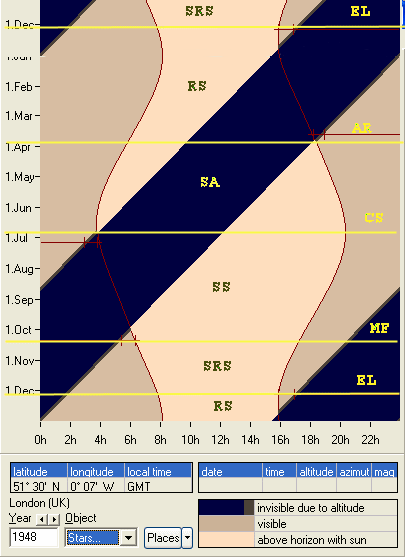 Arcturus' visibility (using PLSV)
Arcturus' visibility (using PLSV)
The naked eye apparent Phases and Periods are:
- EL (~Dec 1947)
- RS (~Dec 1947 to ~March 1948)
- AR (~April 1948)
- SA (~April 1948 to ~June 1948)
- CS (~July 1948)
- SS (~July 1948 to ~Oct. 1948)
- MF (~Oct. 1948)
- SRS (~Oct. 1948 to ~Nov. 1948)
- EL (~Dec. 1948)
Arcturus is of CP Type (as indicated by the sequence MF -> EL
-> AR -> CS).
Remark:
***Theoretically there could be a CPa(Type Code=2) and CPb(Type
Code=3); the difference that the sequence AR - CS is swapped. No
calculations resulted consistently in the MF -> EL -> CS
-> AR sequence. This sub phase (Type Code=2) might though
happen, see
above picture. There
are only CP(Type Code=3)
Ptolemy's
calendar entries also, no CPa(Type Code=2).
ALH Types
There are two sub types of ALH (Arisen and Laying Hidden):
ALHa (south of the ecliptic) and ALHb (somewhat northern and
southern of ecliptic). Ptolemy also recognises these two sub
Types: ALHa as night-pathed and ALHb as dock-pathed (Evans,
1998, pp 193-196).
ALHa Type star
This is an example for Sirius (RA= ~7h:DEC= ~17; including
refraction [Apparent], but no detailed meteorological conditions
as PLSV does not include this):
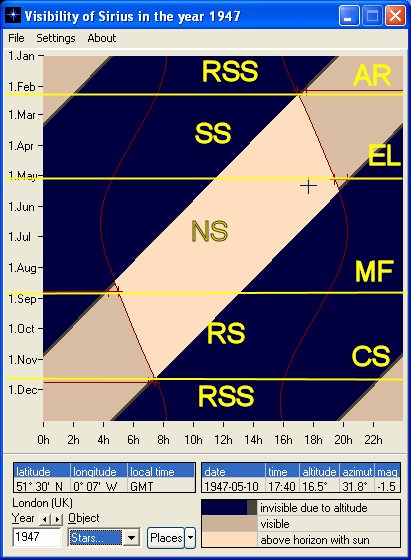 Sirius' visibility (using PLSV)
Sirius' visibility (using PLSV)
The naked eye apparent Phases and Periods are:
- AR (~Feb 1947)
- SS (~Feb 1947 to ~April 1947)
- EL (~May 1947)
- NS (~May 1947 to ~Aug. 1947)
- MF (~Sep. 1947)
- RS (~Sep. 1947 to ~Nov. 1947)
- CS (~Nov 1947)
- RSS (~Nov 1947 to ~Feb. 1948)
- AR (~Feb. 1948)
Sirius is of ALHa Type (as indicated by the sequence: EL ->
MF -> CS -> AR).
ALHb Type
This is an example for a star (RA=18h:DEC=-25; including refraction
[Apparent], but no detailed meteorological conditions as PLSV does
not include this):
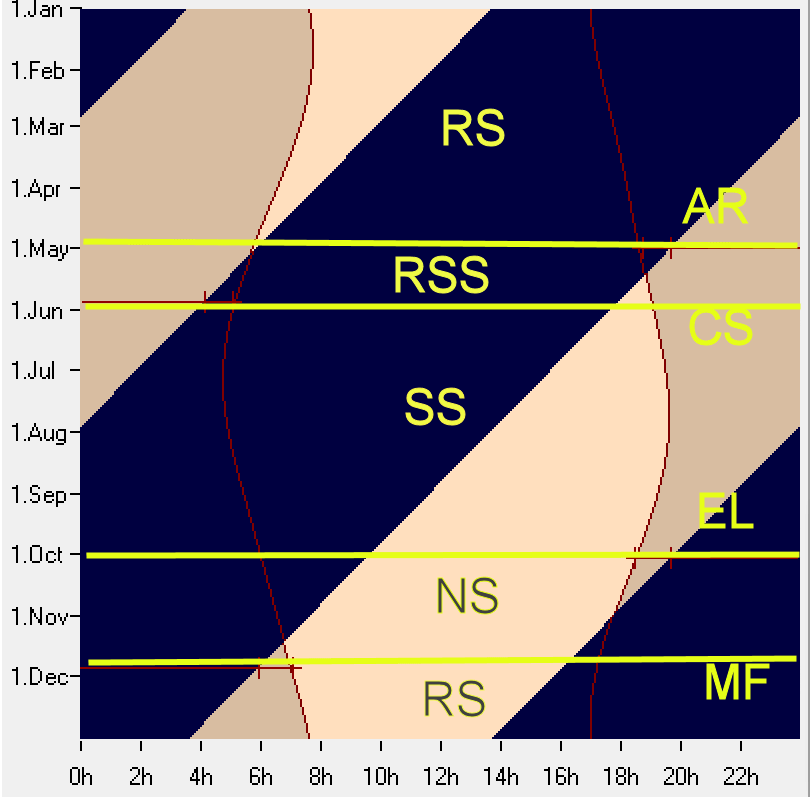 Star's (RA=18h, DEC=-25) visibility (using PLSV)
Star's (RA=18h, DEC=-25) visibility (using PLSV)
The naked eye apparent Phases and Periods are:
- AR (~May -2294)
- CS (~June -2294)
- SS (~June -2294 to ~Sep. -2294)
- EL (~Oct. -2294)
- NS (~Oct. -2294 to ~Nov. -2294)
- MF (~Nov. -2294)
- RS (~Nov. -2294 to ~May. -2293)
- AR (~May -2293)
This star is ALHb Type (as indicated by the sequence: EL -> MF
-> AR -> CS).
References
Bernadette Brady. "The Egyptian ascension mythology of the Old
Kingdom and the phenomenon of star phases." Paper presented at the
Current research in Egyptology Durham University, UK, 2011.
Evans, James, The history and practice of ancient astronomy:
Oxford University Press, USA, 1998.
Rumen Kolev. The Babylonian astrology & astronomy: The
heliacal phases. Vol. 1, 2006.
Rumen Kolev. "Acronychal Rising." Pers. comm: Aug 2009.
Rumen Kolev, "The Babylonian astrolabe: The calendar of creation",
Neo Assyrian text corpus project, 2013.
Lehoux, Daryn Rosario. 2000. 'Parapegmata: Astrology, Weather, and
Calendars in the Ancient World', University of Toronto.
Jean Meeus. "Heliacal rising and setting." In Mathematical
astronomy morsels, 289-96: Willmann-Bell, 1997.
Neugebauer, Otto. 1975. History of ancient mathematical astronomy
(New York: Springer Science).
Planetary,
Lunar and Stellar Visibility Version 3.1.0. Alcyone.
Ptolemy, Claudius, Ptolemy's Almagest. Translated by G.J. Toomer:
Springer-Verlag, 1984.
Claudius Ptolemy. "The
phases of the fixed stars." ed Robert Hand, The Golden Hind
Press, 1993
Schaefer, Brad E., 'Heliacal rise phenomena', Journal for the
History of Astronomy 11, no. xviii (1987): S19-S33.
N.M. Swerdlow. The Babylonian Theory of the Planets: Princeton
University Press, 1998.
Swiss
Ephemeris Version 1.78. Astrodienst.
Robinson, Matthew. 2007. 'Ardua et astra: On the calculation of
the dates of the rising an setting of stars', Classical Philology,
Vol 104: pp. 254-75.
Acknowledgements
I would like to thank the following people for their help
and constructive feedback: Bernadette Brady,
Dieter Koch, Rumen Kolev, Frank Prendergast and all other
unmentioned people. Any remaining errors in methodology or
results are my responsibility of course!!! If you want to
provide constructive feedback, let me know.
Major content related
changes: Sept. 19, 2012

